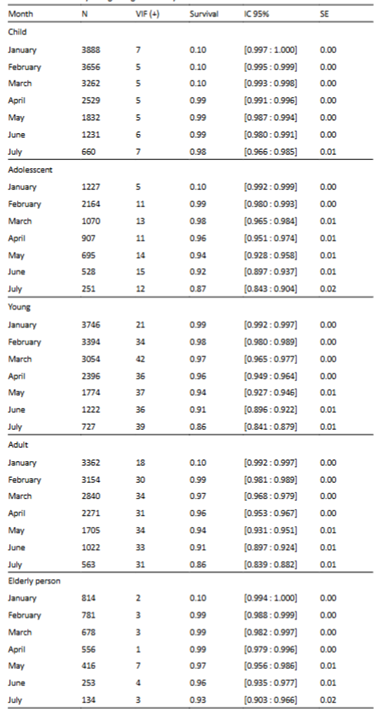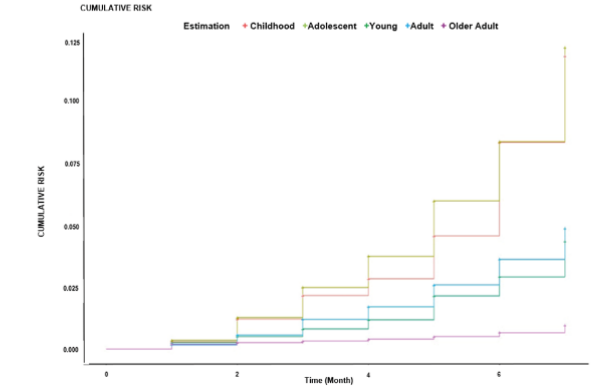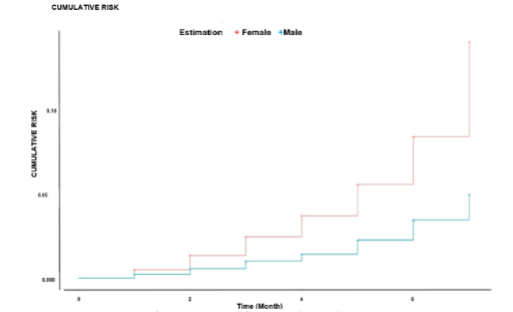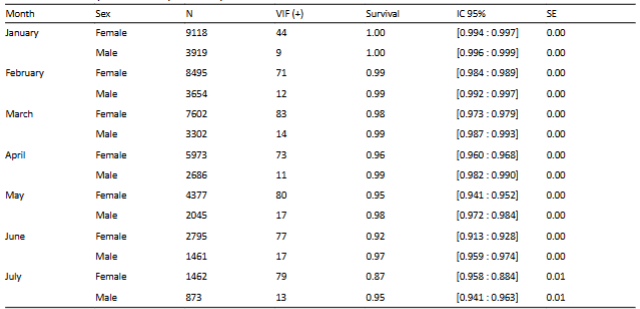INTRODUCTION
Domestic violence encompasses all forms of abuse, both physical and psychological, that occur within relationships among family members, either permanently or through stages such as violence, honeymoon, and tension within the family bond (Pardo et al., 2023). This includes various physical, psychological, economic, etc. types perpetrated by one family member against another Mayor & Salazar, 2019). Similarly, domestic violence is described as a set of abusive actions that take place within the family environment, characterized by a power imbalance among those involved, in which one person exercises authority and control over another. This is manifested through various behaviors that cause physical, psychological, or emotional harm to a family member (Rose et al., 2024). From the psychiatric theoretical model, it is argued that individuals who perpetrate violence against a family member may have a mental disorder (such as sadomasochism). However, the prevalence of domestic violence cases reported due to this factor is minimal ( García et al., 2015). On the other hand, the cultural theoretical model holds that the causes of family violence stem from factors such as socioeconomic status, the power structure in society and the family, economic tensions, as well as institutional and political violence. It is important to emphasize that although these elements are linked to the occurrence of domestic violence, none of them can individually provide a complete explanation of the issue (Junco-Guerrero et al., 2023).
Domestic violence is recognized as a public health issue in several countries (World Health Organization, 2024). Alarming rates of abuse within households are observed in Latin America (Organización Panamericana de la Salud, 2023). For instance, in Colombia, the figures exceed 90% of cases, excluding physical violence, which also shows significant percentages in public spaces (Orozco et al., 2020). Similarly, in Chile, 35.7% of the population has been a victim of domestic violence, including 37.2% experiencing psychological violence, 24.6% suffering from less severe physical violence, 15% facing severe physical violence, and 15.6% enduring sexual violence (Amézquita-Romero, 2014). In addition, Cuba has reported a prevalence rate of 63.4% among women aged 60 to 64, highlighting this demographic as the group with the highest incidence (Rodríguez et al., 2018).
In the Peruvian context, alarming rates of domestic violence have been recorded, particularly in the departments of Apurímac, with 82.7%, and Cusco, with 80.6%, standing out as the areas with the highest percentages (Instituto Nacional de Estadistica e Informatica, 2018). The most vulnerable members, such as women, reported that having a partner with high alcohol consumption was a risk factor for physical abuse, with 52% stating their husbands had physically assaulted them under the influence of alcohol (Flores, 2020). Another study conducted in the Cusco-Peru region revealed that women receiving care at the Centro de Emergencia Mujer in Paucartambo who experience violence within their family environment tend to develop significant emotional dependence on their aggressors (Asmat & Rojas, 2024).
Therefore, this research aimed to identify the prevalence of intrafamily violence among users of a health center in Cusco, Peru. The goal was to obtain crucial data to understand the underlying factors of this issue and, based on these findings, develop effective interventions that promote the mental health and emotional well-being of affected individuals and their families.
METHODS
Research design and settings
This study employs a quantitative approach with a non-experimental, longitudinal, and retrospective design (Rothman & Greenland, 2018). For data collection, the Epidemiological Record for VIF (+) cases was used, which contains the records of users from the Pichari Health Center who experience intrafamily violence and are under case monitoring in coordination with associated entities such as the Centro de Emergencia Mujer and the Family Police of the Pichari district. However, it is essential to note that the records from the Multisectoral Epidemiological Form belong to the Pichari Health Center, as they pertain to users covered by the SIS insurance.
Participants
The sample is non-probabilistic and of an accidental type, comprising 13,040 users at the Pichari Health Center in the department of Cusco, Peru. The data were sourced from the health center's database of users who received outpatient care between January and July 2022. The data collected included users of both sexes, including children, adolescents, young adults, adults, and older adults.
Measures
For the variable of domestic violence, data were collected using the screening tool to identify cases of Intrafamily Violence (VIF (+)) developed by specialists from the Ministry of Health of Peru (2017). This tool is part of the data collection battery used in primary healthcare at Peruvian health centers. It demonstrated statistical reliability with Cronbach’s alpha coefficient of 0.897. Additionally, the instrument was accepted as a protocol aimed at implementing routine procedures for detecting any violence against women and the family unit. It also guides healthcare personnel to provide appropriate care.
Furthermore, specific covariates were collected, including age groups (i.e., children, adolescents, young adults, adults, and older adults) and sex (female and male) based on the requested database.
Data analysis
Initially, a data cleaning process was performed. Once completed, the data was transferred to a matrix in Microsoft Excel 2019. Longitudinal statistical analyses were conducted using RStudio version 2024.09.1. The prevalence of intrafamily violence over time, segmented by developmental stage and gender, was evaluated using survival analysis techniques with the survival package, which allowed for calculating cumulative hazard functions and survival rates. The survminer package was utilized to visualize survival curves and facilitate their graphical interpretation. Longitudinal data were processed to observe changes in prevalence over time, thus assessing the trend of intrafamily violence, with 95% confidence intervals for the survival rates.
Ethical Aspects
It is essential to mention that the data were obtained from secondary databases of primary healthcare services from the Ministry of Health without any information that could identify the patients. Therefore, the data was anonymous and confidential. Approval was also obtained from the Ethics Committee of Universidad Peruana Unión, as documented in Report No. 2023-CE-FCS-UPeU-009.
RESULTS
Survival function by developmental stage
In Figure 1, it is observed that the cumulative risk of domestic violence, which reflects the accumulation of risk factors over time at different stages of development, is highest during adolescence, followed by the young adult stage, with both reaching a cumulative risk higher than 0.10 by the end of the study period. In contrast, the lowest cumulative risk is observed in children and older adults, with values below 0.05, indicating lower cumulative exposure to the risk of violence during these developmental stages. This suggests a greater vulnerability over time for adolescents and young adults than other age groups.
In Table 1, related to domestic violence, broken down by age groups (children, adolescents, young adults, adults, and older adults) and months of the year, the survival values represent the probability of not having experienced a violent event, showing a progressive decrease in the following months. For example, in the adolescent group, the survival rate drops from 0.996 in January (95% CI: (0.992 - 0.999), SE: 0.00182) to 0.873 in July (95% CI: (0.843 - 0.904), SE: 0.01565), indicating an increase in the risk of violence by mid-year. In the adult group, there is a decrease from 0.995 in January (95% CI: (0.992 - 0.997), SE: 0.00126) to 0.86 in July (95% CI: (0.839 - 0.882), SE: 0.01099). Children and older adults have higher survival rates, such as children with 0.998 in January (95% CI: (0.997 - 1.000), SE: 0.00068), although this also decreases to 0.975 in July (95% CI: (0.966 - 0.985), SE: 0.004759). This trend suggests that exposure to domestic violence increases towards the end of the evaluation period, especially among adolescents and adults.
Table 1 Survival analysis regarding intrafamily violence.

Note: 95% CI = 95% Confidence Interval; SE = Standard error of the survival rate; VIF = Intrafamily Violence.
Survival function by gender
In Figure 2, the cumulative risk of domestic violence over time is shown, broken down by gender. Throughout the months, the cumulative risk is consistently higher for females, reaching a value above 0.10 by the end of the period. In comparison, the cumulative risk for males remains lower, around 0.05, within the same time frame. This difference suggests a higher cumulative vulnerability to intrafamily violence in females compared to males throughout the study period.
In Table 2, the survival analysis in the context of intrafamily violence is shown, broken down by gender and month. It can be observed that, in general, women have a lower survival rate compared to men, indicating greater exposure to the risk of violence. For example, in July, the survival rate for women is 0.871 (95% CI: (0.858 - 0.884), SE: 0.006660), while for men it is 0.952 (95% CI: (0.941 - 0.963), SE: 0.005534). This difference suggests a higher accumulated vulnerability in women by mid-year and towards the end of the year. In earlier months, such as January, survival rates are high for both genders, with 0.995 for women (95% CI: (0.994 - 0.997), SE: 0.000726) and 0.998 for men (95% CI: (0.996 - 0.999), SE: 0.000765), reflecting a lower risk during that period. Additionally, the number of intrafamily violence (VIF) cases is consistently higher in women, as in March, where 83 cases were recorded in women compared to 17 in men, which supports the higher accumulated risk observed in women.
DISCUSSION
This research aimed to identify the prevalence of Intrafamily Violence among the users of the Pichari Health Center, located in the department of Cusco. In this regard, we found a higher accumulated prevalence in children, adolescents, and women; additionally, women reported 6 times more cases of intrafamily violence (VIF) than men in all months, while in men, VIF was present in one reported case for every 120 records.
We found a higher accumulated probability that children and adolescents were victims of intrafamily violence. This result is like reports in Peru from the National Survey of Social Relations of Peru - ENARES, which indicated that more than 80% of children and adolescents have been victims of physical and/or psychological violence in their homes and/or schools (Instituto Nacional de Estadística e Informática, 2019). Another study conducted in Brazil with 551 participants reported that the prevalence of domestic violence, such as neglect (33.9%) and sexual abuse (31.9%) in children aged 5 to 10 years, was significant (Porto et al., 2012). These findings are concerning because living in households with intrafamily violence is a risk factor for emotional, physical, and sexual abuse, for developing emotional and behavioral problems, and for increased exposure to other adversities in their lives (Holt et al., 2008). This is an unresolved issue in our country, even though the well-being and health of children and adolescents are considered a fundamental right, and each state must ensure a healthy life and promote well-being at all ages (Ross et al., 2020). Promoting healthy, violence-free family relationships is an ongoing task that could be addressed through the implementation of more community-based mental health centers.
The women studied had a higher accumulated probability of experiencing intrafamily violence compared to men. In this regard, various reports show similar findings, such as the one conducted in the United States, which found that one in every woman was a victim of domestic violence, including economic, physical, sexual, or psychological abuse (Huecker et al., 2023), in Uruguay, a 2019 report stated that one in five women reported being a victim of violence by their partner in the past 12 months (United Nations International Children’s Emergency Fund, 2019); Meanwhile, a 2024 global report by the World Health Organization indicated that one in three women were subjected to physical or sexual violence by their partner, with the highest rates occurring between the ages of 15 and 49 ((World Health Organization, 2024). These findings confirm that intrafamily violence is a phenomenon that transcends cultures and economic levels, and its statistics are alarming. Intrafamily violence is a phenomenon that transcends cultures and economic levels and can be explained through the theory of the cycle of violence (Walker, 1979), which describes a cyclical pattern of tension buildup, episodes of violence, and reconciliation that can manifest in any cultural, social, and economic context. On the other hand, the social ecology theory posits that multiple levels of the social environment, from direct family relationships to cultural norms, influence human behavior and can perpetuate violence, asserting that intrafamily violence is influenced by power dynamics and contextual factors that are universal, thus explaining its presence across various cultures and economic levels (Urie Bronfenbrenner, 1979).
On average, women reported up to six times more cases of intrafamily violence than men in all months. While no studies have reported the same proportion, some studies have reported somewhat similar results, such as the report from the United Kingdom, where 6.9% of women and 3.0% of men reported being victims of domestic violence, showing that the proportion of women victims of violence is double that of men (Office for National Statistics, 2022), similarly, in the United States, twice the proportion of women (e.g., 1 in 4 women and 1 in 9 men) were victims of domestic violence (Huecker et al., 2023). The higher prevalence of intrafamily violence victims among women in our study, compared to prevalence rates in developed countries like the United Kingdom and the United States, could be attributed to factors such as gender inequality, cultural acceptance of violence as a means of conflict resolution (Sardinha & Catalán, 2018) and higher levels of poverty and unemployment, which increase stress and conflict within the home (Mannell et al., 2022), This finding suggests the implementation of public policies to reduce intrafamily violence, mainly based on poverty and unemployment levels among women.
For every 120 individuals screened with the IPV tool, one case of intrafamily violence directed at males was reported. Although the prevalence is lower than that in women, studies have reported that the prevalence of domestic violence against men varies by country and culture, with reported rates ranging(Kolbe & Büttner, 2020) from 3.4% to 20.3%, with psychological violence being more common than physical violence among men . Risk factors for men becoming victims of intrafamily violence include their reluctance to identify their experiences with terms such as "domestic violence victim" due to traditional masculinity norms and associated stigmas. Other factors include the lack of support services specifically for men, their devotion to their families, fear of being judged by others (Moore, 2021), and inadequate responses from the police and judicial system when reporting incidents (Huntley et al., 2020). Therefore, in the Peruvian context, it is necessary to implement specialized centers for the care of intrafamily violence cases directed toward men.
Limitations
This study has certain limitations that should be considered when interpreting the results. Firstly, the sample used was non-probabilistic and accidental, which may limit the generalizability of the findings to other populations. It is also essential to consider that the IPV Screening Form used, while reliable, may not capture all forms of intrafamily violence, especially those that are not reported by the victims.
Conclusions and recommendations
Intimate partner violence in the district of Pichari, La Convención province, Cusco department, Peru, shows a higher cumulative prevalence in children, adolescents, and women. Additionally, women experienced IPV six times more frequently than men in all months, while in men, IPV was reported once in every 120 records. These findings highlight the urgent need to implement evidence-based preventive interventions to reduce the incidence of intimate partner violence. Furthermore, future studies could implement interventions aimed at decreasing domestic violence.


















